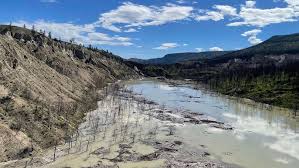Flash Floods ‘Imminent’ After Chilcotin Landslide, Officials Warn
A local state of emergency has been declared by the Tŝilhqot’in National Government (TNG) following a significant landslide that has blocked the Chilcotin River in British Columbia’s Cariboo region. The landslide, which occurred upstream of Nagwentled (Farwell Canyon), is causing a buildup of water that poses a high risk of flash flooding.
Emergency officials have warned that flash floods could occur within the next 24 to 48 hours. Cariboo Regional District chair Margo Wagner highlighted the urgent situation, explaining that the river is expected to breach the landslide eventually, which could lead to severe flooding downstream.
Nathan Cullen, B.C.’s Minister of Water, Land, and Resource Stewardship, described the landslide-created dam as being 600 meters wide and 30 meters deep. B.C. Emergency Preparedness and Climate Change Minister Bowinn Ma added that water is slowly leaking through the dam, increasing the risk of a sudden breach.
A flood warning has been issued for the Chilcotin River upstream of the landslide, and a flood watch is in effect for the Fraser River from the Chilcotin River downstream to Hope, B.C. Residents along these rivers are advised to stay away from the riverbanks and be prepared for potential evacuation orders.
The Cariboo Regional District has already issued evacuation orders for a dozen homes affecting 13 residents due to the immediate flood risk. The evacuated area includes 60 parcels of land along the river, covering approximately 106 square kilometers.
Efforts are underway to assess the landslide’s impact and prepare for potential flooding. The B.C. Wildfire Service is assisting with aerial assessments and search and rescue operations. The province is ready to deploy additional resources, such as sandbags and gabions, to protect communities.
One man was rescued after being trapped by the landslide and transported to the hospital. No other injuries have been reported. The area affected by the landslide had previously been destabilized by a wildfire in 2017, which burned the vegetation that helped stabilize the soil.

